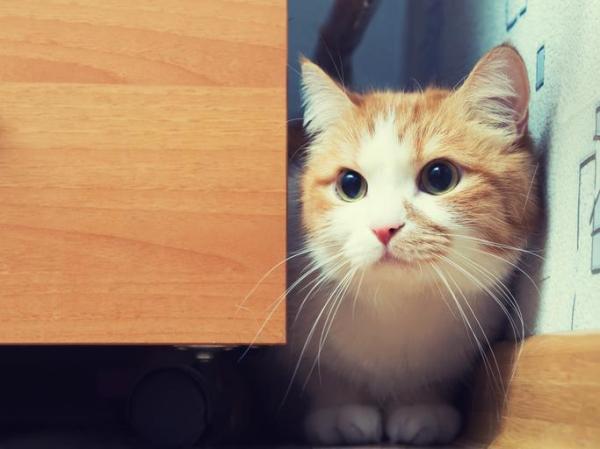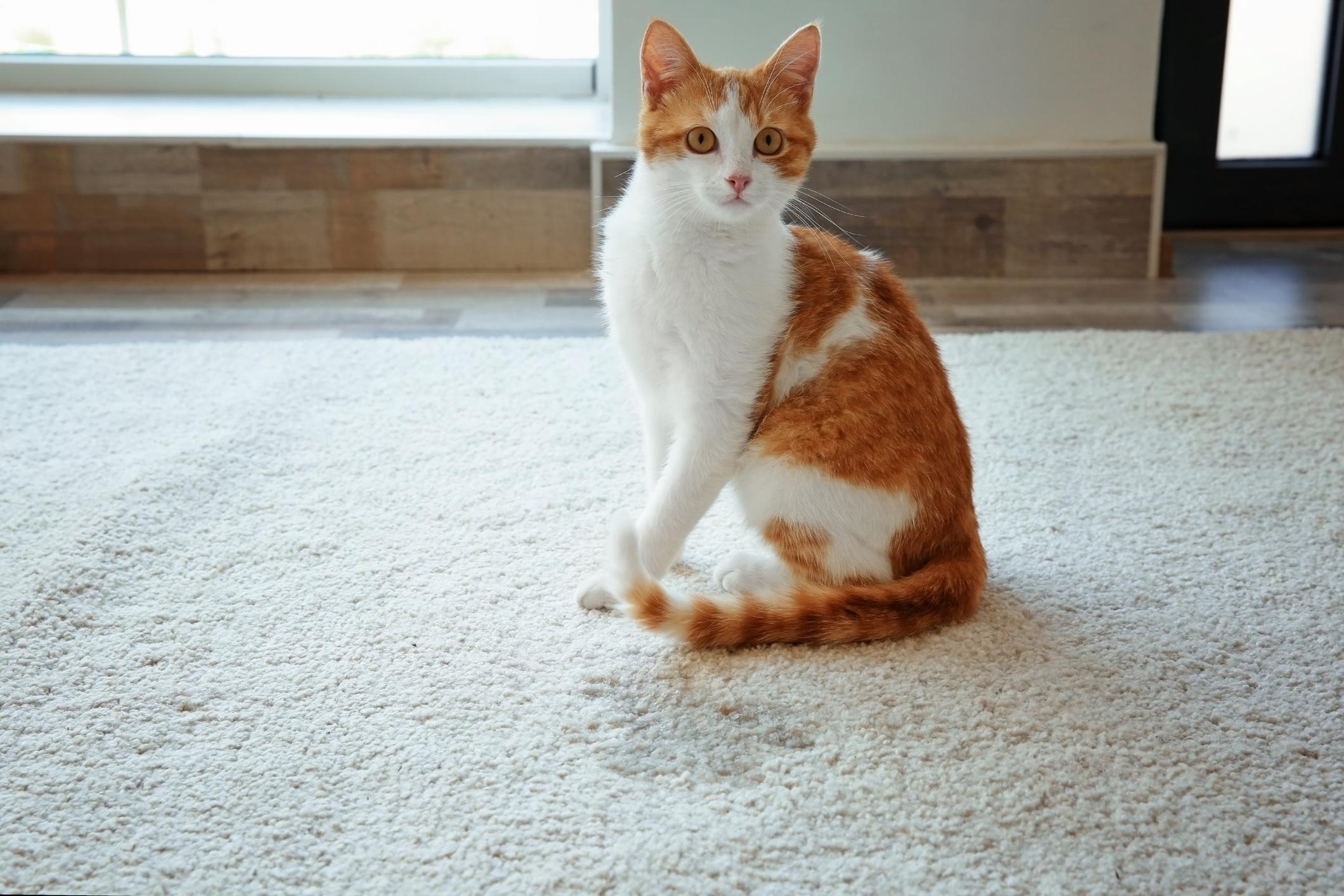My Neutered Cat Is Spraying Everywhere



See files for Cats
The reason why we neuter our cats is primarily for the benefit of both the individual cat and the larger feline population. In addition, there are certain benefits to us as cat guardians. Stopping spraying, marking and urinating outside of the litter box is one of the most practically beneficial in terms of hygiene. This happens because female cats spray during their heat period to attract males. Male cats spray urine to show females they are in the vicinity for copulation. Although mating is not the only reason for spraying, neutering cats is one of the best ways to prevent this behavior.
Since castration and spaying help to stop or reduce spraying in cats, we may be very confused if we see our neutered cat is spraying everywhere. AnimalWised investigates the reasons why neutered cats spray, as well as looking how to stop or redirect this behavior.
Urinary diseases
Diseases of the urinary tract or those which affect urination of the feline can occur in both male and female cats. The most common of these diseases are combined into the generic category term of feline lower urinary tract disease (FLUTD).
Symptoms of feline lower urinary tract disease include spraying everywhere in the home, as well as short and frequent urination, blood in the cat's urine, pain during urination, difficult urinating or inappropriate urination outside of the litter box. If they have been previously litter trained and normally urinate in the litter tray, a cat peeing outside the litter box means they have a physical or psychological issue leading them to do so.
Spraying or peeing outside of the litter box is usually the first sign a guardian will notice to indicate our cat has a urinary disease. The reason they pee outside it is either because they are unable to reach the litter box in time or they associate it with the pain which accompanies urination.
Some of the diseases that can cause FLUTD in cats are the following:
- Feline idiopathic cystitis (50-70%)
- Urolithiasis (15-20%)
- Urethral plugs (10-20%)
- Anatomical defects (10%)
- Urinary tract infection (1-8%)
- Lower urinary tract tumors (1-2%)
Inappropriate urination outside the litter box is most frequent in cases of idiopathic cystitis, urolithiasis, urinary tract infections and lower tract tumors. We should note cats with feline lower urinary tract disease usually spray smaller amounts of urine, although they may do so more frequently. Below we look at these different causes of FLUTD in more detail.
Feline idiopathic cystitis
Feline idiopathic cystitis is a disease that affects the bladder and is closely related to stress. We will talk about it in greater depth in the next section.
Urolithiasis
Urolithiasis or the creation of sediment in the feline urinary tract, called stones or uroliths. They can also affect the upper urinary tract, i.e., the kidney and ureter. These stones occur when an excess of certain minerals is present in the urine. In felines, the most frequent uroliths are those made of struvite and calcium oxalate. We can notice this excess of minerals when we see crystals in the cat's urine.
Unlike dogs, struvite stones in cats are rarely associated with bacterial infection. They are made of phosphate, ammonium and magnesium. They appear most frequently in 3-6 year old Oriental cats that eat little water, are overweight and sedentary and have alkaline urine with a pH greater than 6.5.
Calcium oxalate uroliths are formed when acidic urine becomes saturated with calcium and oxalate. They are more frequent in males, although they can also appear in overweight and sedentary spayed females with hypercalcaemia and low water intake. This problem causes pain when urinating, leading to inappropriate elimination of urine at home.
Urinary tract infections
Urinary tract infections are generally caused by bacteria such as E.coli, Streptococcus, Staphylococcus and Proteus spp. Although rare, they develop more in females. They generally appear in cats with low local immunity, an anatomical defect in the glycosaminoglycan layer of the bladder or due to changes in urine quality or urination. They are also secondary to diseases such as chronic kidney disease, the use of immunosuppressive drugs such as corticosteroids or chemotherapy,hyperthyroidism, hyperadrenocorticism, diabetes, or transitional cell carcinoma of the bladder.
Inappropriate urination outside the litter box is a symptom of a UTI. Painful drop-by-drop urination, incontinence, and blood in the urine.
Lower urinary tract tumors
Tumors of the lower urinary tract have a low prevalence. When they do occur, they usually affect the bladder and transitional cell carcinoma is the most common. It is very aggressive, invades deep layers of the mucosa of the bladder and can metastasize to the liver, lungs and other organs. Clinical signs may be painful urination, blood in the urine, dripping urination and inappropriate urination as can be seen by spraying in the home.
To prevent these diseases it is important that our cats are at their ideal weight, they maintain good daily physical activity and are properly hydrated.
Stress
Our cats love routine. Anything which upsets their routine or breaks their habits may be a source of stress. This could be the introduction of a new pet, a new human family member, a change of address, unfamiliar noises or even something as seemingly insignificant as renovating a room. Stress in cats has many negative consequences. Although we may commonly think of behavioral changes in the cat, physical symptoms can also manifest.
When a neutered cat is stressed, they may start to spray inappropriately in the home. They do so because marking their territory is a way they can feel safe in an environment which is causing them to feel insecure. By spreading their scent, they can make the home feel more familiar in the face of a stressful change. This can also happen during the early days of a new adoption since the cat may need some time to adjust to their new environment.
In addition to spraying everywhere, you can learn about the other signs of stress in cats.
Feline idiopathic cystitis (FIC) is the most frequent cause of FLUTD and is related to stress in cats. Stress causes a deficiency in the response of hormones and the sympathetic nervous system. It is more prevalent in young or middle-aged cats, cats which are fed dry feed exclusively and cats which are overweight, as well as neutered cats. It can also appear as a secondary effect of alterations in the bladder, a decrease in the vesical glycosaminoglycan layer that protects the bladder wall and due to a high concentration of compounds in the urine that induce inflammation.
Idiopathic cystitis consists of a non-infectious inflammation of the urinary bladder with periods of remission and relapse. It manifests in clinical signs such as inappropriate urination, difficulty or pain during urination and frequent low-quantity urination.
Due to its pervasiveness, this is usually the most common reason why a neutered cat is spraying everywhere.

Marking
Although cats mark with their urine, it can be helpful to note the difference between marking territory and urinating. With urination, the cat is expelling waste matter which and essential part of digestion and metabolism. We train them to do this in a litter tray. Unless they have not been trained, urinating outside the litter box mean they have a problem.
Marking can be performed by evacuating a small amount of urine. They do this forcefully so that it sprays out of their urethra. It is for this reason it is known as spraying. Spraying with force allows them to mark higher on walls or trees, making it easier for other cats to smell their scent. They do this to show other cats and animals that this is their territory. They also do it for themselves to feel secure when they recognize their own scent. The urine they use to mark has more of the scent chemicals they use for recognition, so it will usually smell more pungent.
This marking behavior is also performed when the cat rubs their face against you, rubs their sides against objects or scratches their claws on furniture. This is because scents are released from glands in the face, flanks and paws of cats.
However, a neutered cat with a safe home and their basic needs covered will not usually mark with urine. They have been trained to urinate in the litter tray. While scratching and rubbing will help them to know they are in their own territory, these actions also have other purposes such as conditioning their claws and showing affection to their guardians.
Before a female cat is neutered, they will mark to show notify male cats in the area that they are ready to mate. Male cats will mark to notify females, as well as deter other males from taking their place. Once they are neutered, they will mark their territory because they feel insecure. This will be because of stress, routine changes or even physical health. Cats are good at hiding pain and other symptoms of disease, so marking may be the only symptom we notice when there is a problem.
Problems with their litter box
Cats are very hygienic animals. We can see this in their extensive self-grooming habits. They extend similar hygiene requirements for their litter box. If feces and urine accumulate too much, the cat will urinate elsewhere. Some cats are more particular than others. Even if it is clean, if the cat's litter is the wrong type, whether due to texture, odor or materials, they may also spray elsewhere in the home to show their disapproval.
Not only do we need to provide a litter box, but we need to ensure it meets the needs of every cat in the home. You may think it is okay for two cats to share one litter box, but this is not true. Ideally, you should provide three litter boxes for a home with two cats and an additional box for every other cat in the home. This allows the cat privacy and an alternative when one seems unsuitable.
The size of the litter box is also important. Larger cat breeds such as the Maine Coon will not be able to comfortably use a small litter box. As a general rule of thumb, the litter box should be large enough for the cat to enter completely and have enough room to turn around comfortably. Generally, uncovered litter boxes are better, but this will depend on the individual cat.
Placement of the litter box is also important. It needs to be somewhere quiet, clean, free of other odors and away from where they eat and sleep. Hygiene needs to be maintained with droppings cleaned daily and the cat litter should be topped up every 2-3 days if we are removing stools and changed completely once a week. This will go a long way to stop a neutered cat spraying in the home.
Other diseases
In addition to disorders of the lower urinary tract, spayed and neutered cats can urinate everywhere due to other types of organic diseases. These usually have polydipsia and polyuria as symptoms, i.e. an increased thirst and increased need to urinate, respectively. These diseases include feline diabetes mellitus, hyperthyroidism and hyperthyroidism. Kidney disease is also a possible cause, although it is more common in senior neutered cats.
Other problems that can cause your cat to urinate where they shouldn't are those that cause incontinence. Examples include certain neurological problems that affect the spinal cord of the lumbosacral region or the hypogastric, pudendal or pelvic nerves, as well as alterations in the sphincter mechanism of the urethra.
What to do if my neutered cat sprays everywhere
Before getting angry with your neutered cat for urinating where they shouldn't, we need to investigate why. As you have seen many of the problems are physiological and some are even the indirect fault of caregivers. The first thing you should do is take the cat to a veterinarian for an examination. They will be able to help diagnose the problem or at least point us in the right direction.
Some of the things you can do to prevent your cat from spraying outside the litter box may be the following:
- Change the litter box: choose a more suitable litter box, litter type and location for your cat. Move it to a quiet place away from its sources of food and drink. Do not forget to clean it frequently. In this other post we talk about the different types of cat litter and we help you choose.
- Remove stress: if the source of stress can be eliminated, remove or avoid it. If this is not possible, reduce their stress levels by using feline pheromones to create a calmer and happier environment for your cat. Add more scratching posts to so they can mark their territory in other ways and provide platforms, hiding places and other areas your can can feel relaxed. Check out the video below for more information on relaxing a cat.
- Treat FLUTD: to treat feline lower urinary tract disease, you will need to determine its cause via veterinary diagnosis. Once this occurs, they will suggest what treatment may be administered. This may include antibiotics to treat bacterial infections, dietary changes to stop urolith development and kidney problems, chemotherapy or surgery for tumors and even anti-depressants in some cases. Whatever the treatment, it will be determined by your veterinarian after careful diagnosis.
- Other disease treatment: treatment for the organic, endocrine or neurological disease will also be required. This will be via a specific treatment for the problem in question.
Spraying everywhere in the home is not the only problem related to improper waste removal. Learn more with our article on why a cat poops on the bed.

If you want to read similar articles to My Neutered Cat Is Spraying Everywhere, we recommend you visit our Behavioral problems category.
- S, Atencia. (2020). Feline Urology II, Lower Urinary Tract Diseases of the Cat. Improve International.






